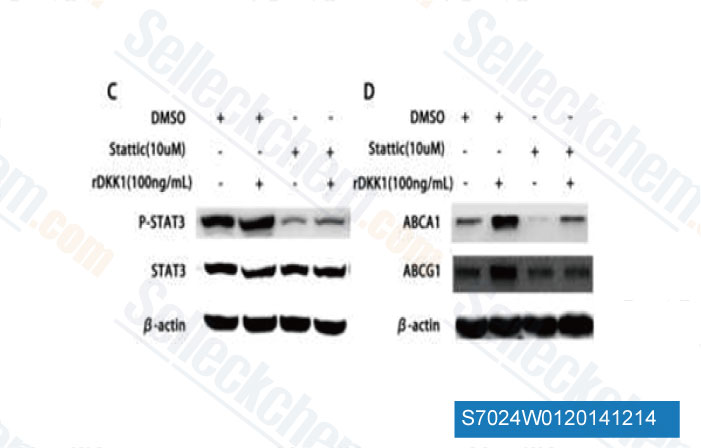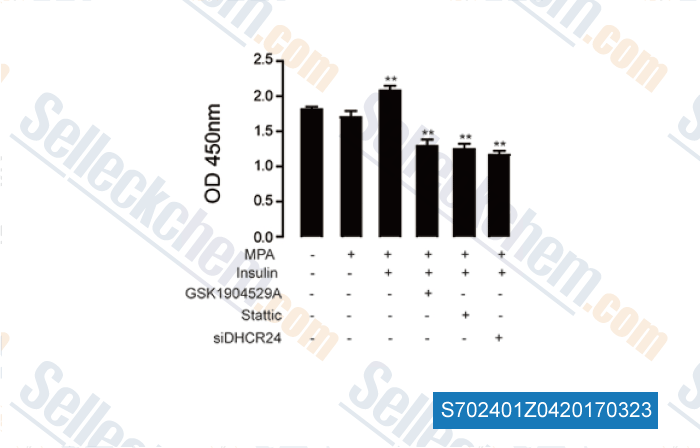|
Toll Free: (877) 796-6397 -- USA and Canada only -- |
Fax: +1-832-582-8590 Orders: +1-832-582-8158 |
Tech Support: +1-832-582-8158 Ext:3 Please provide your Order Number in the email. |
Technical Data
| Formula | C8H5NO4S |
||||||
| Molecular Weight | 211.19 | CAS No. | 19983-44-9 | ||||
| Solubility (25°C)* | In vitro | DMSO | 42 mg/mL (198.87 mM) | ||||
| Water | Insoluble | ||||||
| Ethanol | Insoluble | ||||||
| In vivo (Add solvents to the product individually and in order) |
|
||||||
|
* <1 mg/ml means slightly soluble or insoluble. * Please note that Selleck tests the solubility of all compounds in-house, and the actual solubility may differ slightly from published values. This is normal and is due to slight batch-to-batch variations. * Room temperature shipping (Stability testing shows this product can be shipped without any cooling measures.) |
|||||||
Preparing Stock Solutions
Biological Activity
| Description | Stattic, the first nonpeptidic small molecule, potently inhibits STAT3 activation and nuclear translocation with IC50 of 5.1 μM in cell-free assays, highly selectivity over STAT1. Stattic induces apoptosis. | ||
|---|---|---|---|
| Targets |
|
||
| In vitro | Stattic inhibits binding of a phosphotyrosine-containing peptide derived from the gp130 receptor to the STAT3 SH2 domain in a strongly temperature-dependent manner. Stattic only has a very weak effect on binding of a tyrosinephosphorylated peptide to the SH2-domain of the tyrosine kinase Lck. And it doesn’t inhibit dimerization of two other dimeric transcription factors (c-Myc/Max and Jun/Jun). It also inhibits fluorescein-labeled phosphopeptides to the SH2 domains of STAT1 and STAT5b. Stattic selectively inhibits DNA binding of STAT3 homodimers at a concentration of 10 μM. Shown to inhibit cellular phosphorylation of STAT3 at Tyr705 with little effect towards STAT1 phosphorylation at Tyr701 (in HepG2 cells) or the phosphorylation of JAK1, JAK2, and c-Src (in MDA-MB-231 and MDA-MB-235S cells). Stattic increases the apoptotic rate of STAT3-dependent breast cancer cell lines. [1] |
||
| Features | Stattic is the first non-peptide small molecule with inhibitory activity against STAT3 SH2 domain regardless of the STAT3 phosphorylation state in vitro. |
Protocol (from reference)
| Kinase Assay: |
|
|---|---|
| Cell Assay: |
|
| Animal Study: |
|
References
|
Customer Product Validation

-
Data from [Data independently produced by FEBS Lett, 2014, 10.1016/j.febslet.2014.11.023]

-
Data from [J Biol Chem, 2013, 288(8), 5553-61]

-
, , Sci Rep, 2017, 7:41404

-
Data from [Data independently produced by , , Cell Signal, 2017, 32:48-58]
Selleck's Stattic has been cited by 285 publications
| A patient-derived T cell lymphoma biorepository uncovers pathogenetic mechanisms and host-related therapeutic vulnerabilities [ Cell Rep Med, 2025, S2666-3791(25)00102-8] | PubMed: 40147445 |
| VSIG4+ tumor-associated macrophages mediate neutrophil infiltration and impair antigen-specific immunity in aggressive cancers through epigenetic regulation of SPP1 [ J Exp Clin Cancer Res, 2025, 44(1):45] | PubMed: 39920772 |
| Triptolide alleviates acute lung injury by reducing mitochondrial dysfunction mediated ferroptosis through the STAT3/p53 pathway [ Free Radic Biol Med, 2025, 230:79-94] | PubMed: 39914683 |
| Methylstat sensitizes ovarian cancer cells to PARP-inhibition by targeting the histone demethylases JMJD1B/C [ Cancer Gene Ther, 2025, 10.1038/s41417-025-00874-z] | PubMed: 39915607 |
| Intracellular CIRP promotes liver regeneration via STAT3 signaling pathway activation after partial hepatectomy in mice [ Int J Mol Med, 2025, 55(3)42] | PubMed: 39791211 |
| Type 3 deiodinase activation mediated by the Shh/Gli1 axis promotes sepsis-induced metabolic dysregulation in skeletal muscles [ Burns Trauma, 2025, 13:tkae066] | PubMed: 39877839 |
| Bone morphogenetic protein 4 derived from the cerebrospinal fluid in patients with postherpetic neuralgia induces allodynia via the crosstalk between microglia and astrocyte [ Brain Behav Immun, 2024, 119:836-850] | PubMed: 38735405 |
| Bone morphogenetic protein 4 derived from the cerebrospinal fluid in patients with postherpetic neuralgia induces allodynia via the crosstalk between microglia and astrocyte [ Brain Behav Immun, 2024, S0889-1591(24)00395-7] | PubMed: 38735405 |
| Cancer-associated fibroblast-derived periostin promotes papillary thyroid tumor growth through integrin-FAK-STAT3 signaling [ Theranostics, 2024, 14(7):3014-3028] | PubMed: 38773979 |
| Understanding the molecular pathway of triclosan-induced ADHD-like behaviour: Involvement of the hnRNPA1-PKM2-STAT3 feedback loop [ Environ Int, 2024, 191:108966] | PubMed: 39167854 |
RETURN POLICY
Selleck Chemical’s Unconditional Return Policy ensures a smooth online shopping experience for our customers. If you are in any way unsatisfied with your purchase, you may return any item(s) within 7 days of receiving it. In the event of product quality issues, either protocol related or product related problems, you may return any item(s) within 365 days from the original purchase date. Please follow the instructions below when returning products.
SHIPPING AND STORAGE
Selleck products are transported at room temperature. If you receive the product at room temperature, please rest assured, the Selleck Quality Inspection Department has conducted experiments to verify that the normal temperature placement of one month will not affect the biological activity of powder products. After collecting, please store the product according to the requirements described in the datasheet. Most Selleck products are stable under the recommended conditions.
NOT FOR HUMAN, VETERINARY DIAGNOSTIC OR THERAPEUTIC USE.
